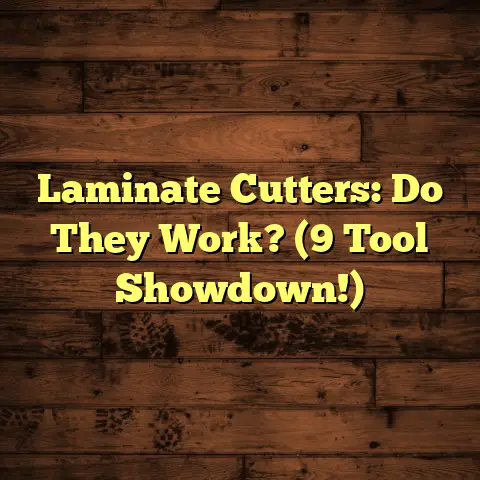Mixed-Use Floors: Emerging Trends? (3 Top Builds!)
I’m excited to dive into a topic that’s been revolutionizing urban landscapes: mixed-use floors.
According to a recent report by the Urban Land Institute, mixed-use developments have increased by over 30% in metropolitan areas over the last decade.
That’s a HUGE shift, right?
It shows how much urban planning and consumer preferences are changing.
Mixed-use floors aren’t just a fad; they’re a smart solution to modern living.
Let’s explore why they’re becoming so popular and check out some amazing examples!
Understanding Mixed-Use Floors
So, what exactly are mixed-use floors?
Think of it as a blend of different worlds under one roof.
It’s where residential, commercial, and recreational spaces come together in a single building or development.
Imagine living above your favorite coffee shop or having your office just an elevator ride away from your apartment.
That’s the beauty of mixed-use floors!
These spaces bring a ton of benefits to urban environments. I’ve seen it firsthand.
They boost foot traffic, encourage community engagement, and really inject economic vitality into the area.
Plus, they can contribute to sustainable urban growth by reducing our dependence on cars.
Think about it: you can walk to work, the grocery store, and even a yoga class.
That’s a win for your health and the planet!
Emerging Trends in Mixed-Use Floors
Now, let’s talk about what’s hot in the mixed-use world.
I’ve noticed three key trends that are really shaping the market right now.
1. Sustainability and Green Design
Eco-friendly materials and energy-efficient technologies are becoming a must-have in mixed-use developments.
We’re talking about things like:
-
Recycled flooring: Think reclaimed wood or recycled rubber.
-
Low-VOC paints and adhesives: These reduce indoor air pollution.
-
Energy-efficient lighting: LEDs are the way to go!
-
Green roofs: These help with insulation and reduce stormwater runoff.
Developers are realizing that sustainability isn’t just good for the environment; it’s also good for business.
Tenants are increasingly looking for spaces that align with their values, and that includes eco-friendly buildings.
2. Smart Technology Integration
Smart homes aren’t just for single-family houses anymore.
They’re making their way into mixed-use developments, and it’s changing the game.
We’re seeing things like:
-
Smart thermostats: These learn your preferences and adjust the temperature automatically.
-
Smart lighting: Control your lights with your phone or voice.
-
Keyless entry: No more fumbling for keys!
-
Building management systems: These monitor energy usage, security, and more.
These technologies enhance convenience, security, and overall quality of life for residents and tenants.
I remember working on a project where we installed smart lighting throughout a mixed-use building.
The tenants loved being able to control the lights from their phones, and the building manager was able to track energy usage in real time.
It was a game-changer!
3. Community-Centric Spaces
People are craving connection more than ever, and mixed-use developments are responding by creating communal areas that foster social interaction.
Think about:
-
Rooftop terraces: Perfect for gatherings and enjoying city views.
-
Community gardens: Grow your own food and connect with your neighbors.
-
Co-working spaces: Work from home without feeling isolated.
-
Shared kitchens: Cook together and share meals.
These spaces are designed to bring people together and create a sense of belonging.
I’ve seen communities thrive when they have access to these types of amenities.
It’s not just about having a place to live or work; it’s about being part of something bigger.
Top 3 Builds Featuring Mixed-Use Floors
Alright, let’s get to the good stuff!
I want to share three exceptional examples of mixed-use developments that really embody these emerging trends.
1. The High Line Hotel (New York City, USA)
This historic hotel is a true gem. It’s not just a place to stay; it’s a destination in itself.
The High Line Hotel seamlessly blends residential, commercial, and communal spaces.
It has a beautiful courtyard that’s open to the public, a popular coffee shop, and even a bookstore.
The architectural design is stunning, with a focus on preserving the building’s historic character.
It really contributes to the local community by providing a gathering place for residents and visitors alike.
Key Features:
-
Location: New York City, USA
-
Mixed-Use Elements: Hotel, residential, commercial, communal spaces
-
Architectural Design: Historic preservation with modern updates
-
Community Impact: Provides a gathering place and enhances the urban landscape
2. Battersea Power Station (London, UK)
This iconic redevelopment project is a testament to the power of mixed-use design.
The Battersea Power Station was once a derelict industrial site, but it’s now a vibrant community with housing, office space, retail, and leisure facilities.
What’s really impressive is its commitment to sustainable design.
The developers have incorporated a range of eco-friendly features, including:
-
Renewable energy sources: Solar panels and geothermal energy.
-
Water conservation measures: Rainwater harvesting and greywater recycling.
-
Green roofs: These help with insulation and reduce stormwater runoff.
This project shows that mixed-use developments can be both beautiful and sustainable.
Key Features:
-
Location: London, UK
-
Mixed-Use Elements: Housing, office space, retail, leisure facilities
-
Sustainable Design: Renewable energy, water conservation, green roofs
-
Impact: Revitalizes a derelict site and creates a sustainable community
3. The Wharf (Washington D.C., USA)
The Wharf is a stunning waterfront development that has transformed the D.C. waterfront.
It’s a vibrant mix of residential, office, and entertainment spaces.
You can live, work, and play all in one place!
The Wharf has really revitalized the area and brought new life to the D.C. waterfront.
It’s a popular destination for locals and tourists alike.
Key Features:
-
Location: Washington D.C., USA
-
Mixed-Use Elements: Residential, office, entertainment spaces
-
Impact: Revitalizes the waterfront and contributes to urban life
The Future of Mixed-Use Floors
So, what does the future hold for mixed-use floors?
I think we’re going to see even more of these developments popping up in cities around the world.
As cities continue to grow and evolve, mixed-use developments will become even more important for creating sustainable, vibrant communities.
Here are a few potential challenges and opportunities that I see on the horizon:
-
Challenge: Affordability Making mixed-use developments accessible to people of all income levels will be crucial.
-
Opportunity: Technology Advancements in technology will continue to shape the design and functionality of mixed-use spaces.
-
Challenge: Community Engagement Ensuring that mixed-use developments truly serve the needs of the local community will be essential.
-
Opportunity: Changing Consumer Preferences As people’s lifestyles and priorities change, mixed-use developments will need to adapt to meet their evolving needs.
Conclusion
Alright, that’s a wrap!
We’ve covered a lot of ground, from the basics of mixed-use floors to the latest trends and some inspiring examples.
I hope you’ve gained a better understanding of why these developments are so important for modern urban living.
Mixed-use floors aren’t just architectural trends; they’re a response to the evolving dynamics of city life.
They offer a way to create more sustainable, vibrant, and connected communities.
And that’s something we can all get behind!
So, the next time you’re walking through a city, take a look around and see if you can spot some mixed-use developments.
You might be surprised by what you find!





